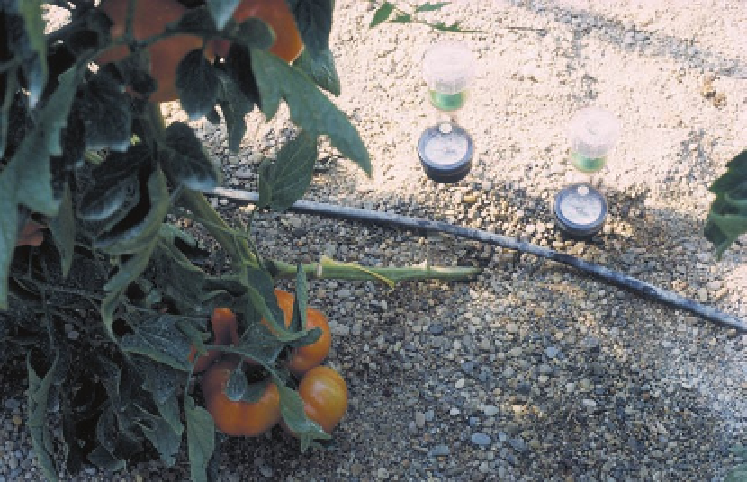Agriculture Reference
In-Depth Information
maintenance (Photo 11.1). Tensiometers use
gauges, but in some models these are being
substituted by pressure transducers, which
are more precise but more expensive, allow-
ing for continuous monitoring.
Tensiometers perform well within the
0-80 kPa matrix tension range. To achieve
exact readings, the correction by gravity in
the water column must be taken into
account, because 10 cm of water column
equals 1 kPa, which in greenhouse irriga-
tion management practice is of little rele-
vance. Nowadays, there are tensiometers in
the market that allow for the automation of
the readings.
house vegetable growing (Thompson and
Gallardo, 2003).
v o l u m e t r i c
m o i s t u r e
s e n s o r s
.
In the past the
neutron probe was used. Nowadays, it has
been substituted by dielectric sensors,
which measure the dielectric constant of
the soil matrix, deducing the value of the
volumetric moisture content in the soil
from it. Two methods are used: (i) TDR; and
(ii) FDR.
TDR is based on measuring the trans-
mission time of an electromagnetic signal
along a metallic probe introduced into the
soil. FDR sensors use the capacitance (the
ability of a body to store an electrical charge)
to measure the dielectric constant of the soil
matrix. FDR sensors have better perform-
ance than those of TDR. A review by
Thompson and Gallardo (2003) on their use
in greenhouses summarizes several aspects
about their use.
Electric resistance sensors.
The principle
behind electric resistance sensors is that the
electrical resistance between two electrodes
is a function of the water content. The most
usual types are plaster blocks, which are of
no use where high-frequency drip irrigation
is used as they do not work efficiently with
high levels of soil moisture. In addition,
they do not last long.
Other similar sensors (granular matrix
sensors) have improved their performance
with respect to the plaster blocks, but
tensiometers are more suitable for green-
Management of tensiometers (in the soil)
In greenhouse high-frequency drip irriga-
tion systems, the recommended intervals of
water tension in the soil lie between 10 and
20 kPa (for soil with a gross texture, i.e. with
Photo 11.1.
Tensiometers are increasingly used in greenhouses.

